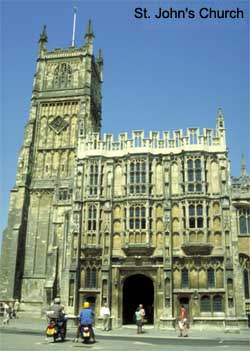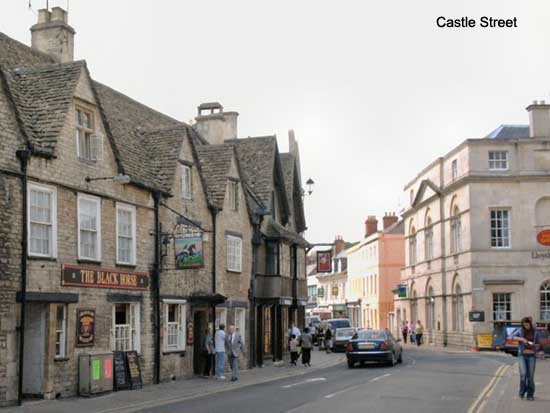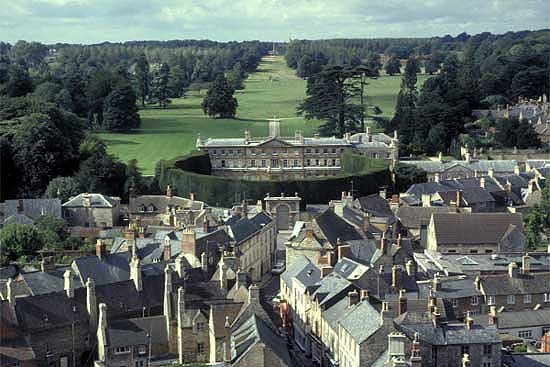Cirencester of the Cotswolds
by Lisa Agnew
 Within the heart of Gloucestershire, at the confluence of three Roman roads (Akeman Street, Ermine Street and the Fosse Way), the astute traveller will find a jewel of a town called Cirencester, the self-styled capital of the Cotswolds. A region much admired for its rustic beauty and depth of history, the Cotswolds rise into hills ('wolds' is an archaic word for 'hills') from the meadows of the upper Thames valley in the east, forming a delightful undulating landscape until it plunges away westward into the Vales of Severn and Evesham. Cirencester forms a gateway to the exploration of this deeply picturesque area. Four thousand years of slowly changing history is on display within the landscape, for it is in no way a natural landscape, having been intensely lived in during the entire length of its history, densely settled even during Roman times. Here the past mingles effortlessly with the present, making it possible to rediscover a sense of place, proportion and harmony in the midst of the English countryside.
Within the heart of Gloucestershire, at the confluence of three Roman roads (Akeman Street, Ermine Street and the Fosse Way), the astute traveller will find a jewel of a town called Cirencester, the self-styled capital of the Cotswolds. A region much admired for its rustic beauty and depth of history, the Cotswolds rise into hills ('wolds' is an archaic word for 'hills') from the meadows of the upper Thames valley in the east, forming a delightful undulating landscape until it plunges away westward into the Vales of Severn and Evesham. Cirencester forms a gateway to the exploration of this deeply picturesque area. Four thousand years of slowly changing history is on display within the landscape, for it is in no way a natural landscape, having been intensely lived in during the entire length of its history, densely settled even during Roman times. Here the past mingles effortlessly with the present, making it possible to rediscover a sense of place, proportion and harmony in the midst of the English countryside.
The town itself is dominated by the Market Place which, as its name suggests, plays host to an outdoor market twice a week (Monday and Friday) and St John Baptist parish church, both of which, like the town in general, owe their prosperity to the Cotswolds' historic wool trade. Two thousand years ago, Cirencester was second only to London in size and importance, built by the Romans after the successful invasion led by Emperor Claudius in 43 AD. In the following years they embarked upon a stoic campaign to subjugate the west country. This was spearheaded by the 2nd Augustan Legion, with the future Emperor Vespasian as their commander. In about 75 AD, the first town was constructed as an administrative and defensive base for the central south-western portion of England and linking the southern-west with the northern-east zones via the Fosse Way. There were at least four major gates in the town's encircling wall, through which the main highway routes entered to cross at the center of this ancient metropolis.
The Corinium Museum in Park Street bears figurative witness to the importance of Roman Cirencester, housing one of England's most impressive collections of Roman antiquities, including many artefacts from within the confines of the town itself, goods which found their way there via trade which flowed along the Roman roads. The museum offers a realistic glimpse into the lives of everyday Romans and Britons of the era via reconstructions of the conditions in which they existed. There are also remains of the amphitheatre on the southern side of one of the town's major thoroughfares -- Bristol Road -- which more than adequately convey the grandeur of an arena which probably played host to cock-fighting and bear-baiting, with the occasional gladiatorial combat on special occasions, although the ruins are now shrouded beneath grass tombs.

Most of the present town of Cirencester dates from the days of the Middle Ages and the wool and cloth merchants, whose houses and warehouses can be seen clustered around Coxwell and Thomas Streets. The Cotswold sheep was a large animal with a long, thick fleece and Cotswold wool eventually provided more than half of England's cloth, as well as a great number of exports to the continent. A beneficiary of such commerce, St John Baptist Church, virtually opposite the Corn Hall on Market Place, rivals many cathedrals in splendour and has a 15th century pulpit, magnificent tower, a fan-vaulted porch, and houses a fine collection of communion plates. The chapels were added by wealthy wool merchants, some of whom are commemorated in brasses in the Trinity Chapel, including Robert Page, who had one wife, six sons, and eight daughters. The church also has a Tudor gilt cup made for Queen Anne Boleyn in 1535, two years before her execution by King Henry VIII. For purely romantic souls, the church graveyard is most picturesque.
The town is spoilt for choice when it comes to parkland. Cirencester Park is Earl Bathurst's vast 300 acre estate, open to the public, which hosts a number of equestrian events throughout the year, including polo every Sunday during the summer (May-September), matches which are often frequented by members of the English Royal family. Almost anyone could spend an entire day losing themselves within the glorious, ever-changing acreage of this park. Then there are the Abbey grounds with remnants of the town's Roman wall but no abbey any longer. Abbey buildings throughout the Cotswolds were razed to the ground in the Reformation. Some, such as the surviving portions of the abbey church at Malmesbury, survived only because they were purchased by private citizens. All that remains of Cirencester's medieval abbey is a fine gatehouse. The Abbey grounds are laid out as a large public park just behind the Market Place. The River Churn flows through these grounds, providing a haven for swans and various other waterfowl. There is a third park on the other side of Cirencester which houses facilities for sports enthusiasts.

There have been several Roman villas excavated in the town's immediate vicinity. Along the length of the A417, which is actually Roman Ermine Street, a recent dig outside Gloucester, near Brockworth, has discovered boundaries enclosing previously unsuspected small fields attached to Hucclecote Roman villa, highlighting the fact that the Roman population found Cirencester and its environs particularly salubrious. Twelve kilometers north of Cirencester are the remains of Chedworth Roman Villa, nestled on a tributary of the River Coln. It is from here that the Corinium Museum acquired its famous floor mosaic, as well as the section of Roman underfloor central heating on display. Within the town itself, only small portions of the Roman retangular street layout can now be discerned, although much has been discovered by excavation. The nucleus of town life was the Forum, an open market area surrounded by colonnaded shops. This area is now lined by the modern streets of Lewis Lane, Tower Street and The Avenue. To the south of the Forum was the Basilica, a huge building 102 meters long and 29 meters wide, which served the Roman public as town hall and judicial courts. A plaque now marks the position of the Seat of Judgement within the disappeared Basilica, at the junction of The Avenue and Tower Street. West of the Forum is present-day Ashcroft Road, where excavation has uncovered a representation of the Celtic Mother Goddesses, Deae Matres, as well as statuary extolling the Roman God Jupiter, all of which are now in the Corinium Museum.
By the 4th century AD, Cirencester was the capital of the Province of Britannia Prima and center of general wealth in the Cotswolds. When the Romans finally retreated from Britain in the 5th century AD, urban life would, in all likelihood, have carried on within the walls of the town. The native British had become well and truly Romanized during the preceding five centuries. Indeed, the native tribe of the area, the Dobunni, had always been allies to their conquerors. It was not until 577 AD that Saxon incursion succeeded in taking the town of Cirencester for their own.

Getting Around:
To do Cirencester and its surrounds any justice at all, a visitor needs to spend at least a week in the vicinity. To reach Cirencester, the main routes are via road and rail. The nearest railway station is Kemble, a few kilometres south of the town. Taxis and buses run from the station to Cirencester's Market Place. By car, one can take the M4 out of London, past Windsor Castle and on into the west, turning north at Junction 15 onto the A419 at Swindon, which will take you directly into Cirencester.
Accommodation in Cirencester in particular, and the Cotswolds in general, ranges from reasonably priced B & Bs (bed and breakfasts), usually housed in spacious residential dwellings, to inns and fully fledged hotels. B & Bs and inns maintain good standards and are often very historic places in themselves. The hotels of the region are always run to high standards -- sometimes also housed in the elegant and/or historic surroundings of a country house.
More Information:
We regret that we no longer have the resources to maintain up-to-date links and/or hours and pricing details for the various sites and attractions listed on this website. For more information about the location(s) listed above, please use your favorite search engine or visit Wikipedia.
Lisa Agnew is a freelance writer of articles and speculative fiction. She is based in Auckland, New Zealand. English by birth, she harbours a life-long fascination with the history and folklore of her native land.
Article © 2006 Lisa Agnew
Photos: St. John's Church, aerial view of town courtesy of BritainonView.com; Amphitheatre courtesy of Chris McKenna (via Wikipedia.org); Castle Street courtesy of Chris Jefferies (via Wikipedia.org).
|
